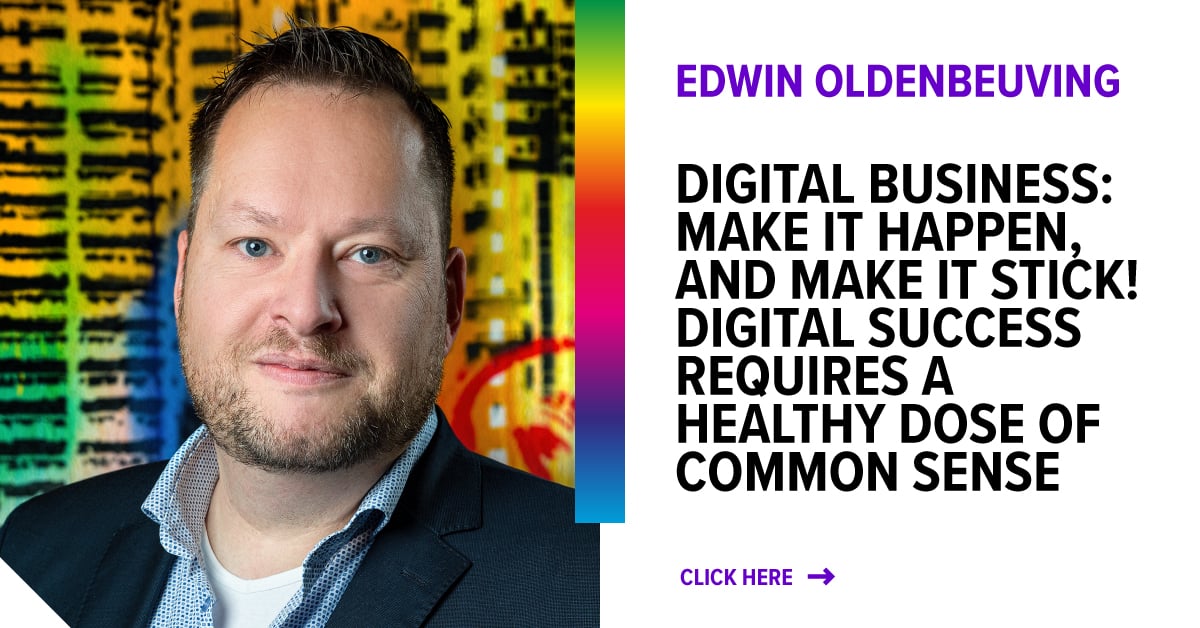Make it Happen, and Make it Stick!
“In this interconnected age, it seems like everyone is hopping on board the digi-train. As a result, the true definition of what it means to be a digital business can get lost in translation. Many companies claim they are in the midst of a digital transformation or are migrating towards digital business, in fact they are only digitizing existing elements of their business; processes, documents, customer experience and more. It’s not surprising that many organizations get stuck in their digital business transformation. Being a digital-driven company requires different skills and ways of working, but in most cases the business structure, strategy and employees stay the same.”
Author of this article is Edwin Oldenbeuving, Edwin Oldenbeuving, Transformation Director Digital Business & Organizational Change. This article is published in the 3rd edition of  . AGILE NXT is the magazine with the essential elements to become a truly Agile organization. It challenges you to improve yourself, your team, and company a little more each day.
. AGILE NXT is the magazine with the essential elements to become a truly Agile organization. It challenges you to improve yourself, your team, and company a little more each day.

To successfully transition a traditional company into a digital one, it’s crucial that the CxOs understand and communicate their strategic goals from the outset. This ensures a continuous alignment between the strategic, tactical and operational levels within the company. Both traditional and digital businesses need to add value through short-cycle processes that are based on continuous feedback and learning from previous experiences. The more effective, efficient and mature the traditional services are, the faster digital business strategies can be implemented and will start to deliver added value in terms of customer needs and other business objectives.
All Grown Up
Another common challenge for companies wanting to migrate to a digital way of working, is the maturity of the existing IT landscape, which often does not (yet) meet the needs of the business. In the past, companies made huge investments in IT systems, including a lot of tailor-made solutions to gain a competitive advantage. However, technological advances have developed so rapidly that today eighty to ninety percent of IT processes can be supported by standard solutions.
So, what choice should management teams make when their current IT landscape is not up to the challenges of the business objectives? Build a bespoke IT system, or buy a standard solution? Costs play a pivotal role in this decision as maintenance and management costs of IT systems can rise exponentially. Additionally, the implementation of new solutions means a substantial investment of time, money, skills, resources and risk. How do you balance these costs with the financial health of the business?
Framework
Instead of building a technology stack and exploring the potential applications afterwards, it’s crucial to establish the business needs and human resources context first. CxOs have to stop hiding behind IT complexity. To run a successful business, they have to understand which processes can be standardized, but also what sets the company apart from the competition and what technologies can help to strengthen that competitive advantage.
There are seven skills that are globally recognized as the determining factors for life and work in the 21st century: cooperation, communication, problem solving, self-reliance, creativity, critical thinking and social and cultural skills. But these are all subordinate to the required framework of IT competencies.

What’s the Problem?
Digitization is causing a shift in scarcity, as certain professions and middle management become superfluous. In parallel, we see a greater need for professionals who can master the new digital complexity, especially where companies are looking to scale up their operations. Simplicity and common sense are the keys to success. As we move through the digital age, from telecom to internet and now, the Internet of Things (IoT), everything can be connected, and that brings with it new possibilities. But companies must keep asking themselves, what problem are we solving for the consumer?
Ask yourself: What is the added benefit for a health care patient if they are helped remotely instead of in-person in a hospital or doctor’s office? What problem is this digital solution solving for the consumer or the market? Too often, there is no clear benefit. A digital solution should not be applied for the sake of it, especially when employees are not even familiar with the implementation and application of the technology.
Positive Culture
Change processes can put enormous pressure on an organization. Often roles and management layers are cut away which can lead to widespread insecurity amongst employees about their own performance and competencies. This negative culture can be prevented. The knowledge and skills that have become superfluous in one part of the business can be put to great use elsewhere. The focus should be on delivering added value in your role, rather than holding onto a certain position in the company.
Most companies will hold onto elements of a traditional hierarchy where employees are all equal, but not the same, Organizations are shifting from functions to roles and adding new competencies when these are needed for short term projects and solutions. The market is developing so fast that it’s no longer realistic to work in the same job for ten to twenty years. Instead, professionals start out with basic skills and—through continuous learning—keep adding to their skill set.
Start Small
Want to get started with digital business? Start small. For example, choose one value stream to optimize (with an Agile mindset) and, if it doesn’t quickly add value, stop and develop a new initiative.
By working transparently, teams and leaders know where to focus and how to manage processes. Don’t start off with an entire digital transformation, just because the whole world seems to be doing it. It’s smarter to focus on short cycle delivery and learning through continuous feedback. In other words, stop starting and start finishing.
A transparent culture where learning and failing is encouraged and teams can work autonomously will yield much better results than wildly ambitious strategies and transformations. This way you are empowering your teams to optimize value streams that give your company a competitive advantage in the market.
Keys to Success
With its results-driven approach, Xebia helps a wide range of companies successfully implement digital change processes. In every organization the focus is on result agility, while the corresponding learning agility is the key to success.
Want to know more about this topic? Download  and start your personal change tomorrow. Let us help you with your transformation and email at Edwin Oldenbeuving.
and start your personal change tomorrow. Let us help you with your transformation and email at Edwin Oldenbeuving.
Only in May 2020, Save 33% on your next virtual classroom!
Join our virtual Agile, Scrum and Leadership classrooms and get Certified. Remote Learning is possible via our Virtual Classroom. Learn from the world’s leading experts. Our courses and locations have been aligned to support distance learning.






